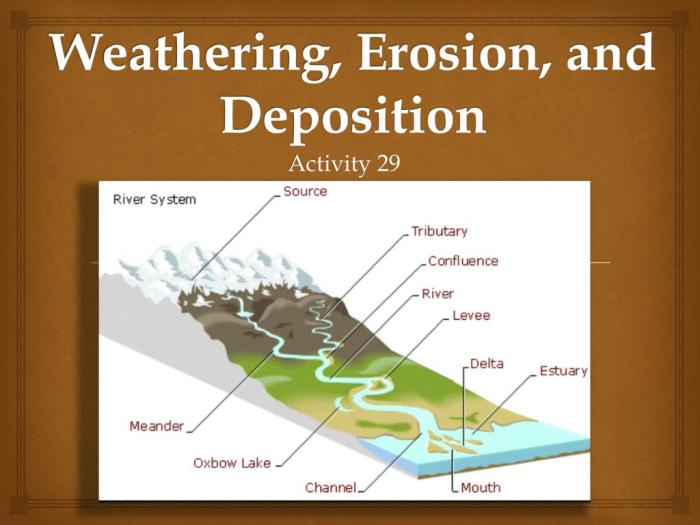Weathering erosion and deposition worksheet – Embark on a journey through the dynamic world of weathering, erosion, and deposition with our comprehensive worksheet. This educational tool provides an immersive exploration of the forces that shape our planet’s surface, fostering a deeper understanding of the Earth’s ever-changing landscape.
Through engaging questions and activities, students will delve into the intricacies of these processes, unraveling their significance in shaping mountains, carving canyons, and creating the diverse landforms that grace our planet.
Weathering, Erosion, and Deposition

Weathering, erosion, and deposition are three fundamental processes that shape the Earth’s surface. Weathering breaks down rocks and minerals into smaller particles, erosion transports these particles away, and deposition accumulates them in new locations.
Understanding these processes is crucial for understanding the formation of landforms, the cycling of nutrients, and the long-term evolution of the Earth’s surface.
Examples of weathering, erosion, and deposition include the formation of soil from bedrock, the erosion of mountains by glaciers, and the deposition of sediment at river deltas.
Types of Weathering

Physical Weathering
- Freeze-thaw weathering: Water seeps into cracks in rocks and freezes, expanding and breaking the rock apart.
- Exfoliation: The outer layers of rock peel away due to temperature changes and pressure release.
- Abrasion: Rocks rub against each other, causing them to break down.
Chemical Weathering
- Hydrolysis: Water reacts with minerals in rocks, breaking them down.
- Oxidation: Oxygen reacts with minerals in rocks, forming new compounds.
- Carbonation: Carbon dioxide in the atmosphere reacts with water to form carbonic acid, which dissolves minerals in rocks.
Biological Weathering
- Plant roots: Plant roots grow into cracks in rocks, breaking them apart.
- Animal burrowing: Animals burrow into the ground, creating cracks and exposing rocks to weathering.
- Microbial activity: Microbes secrete acids that dissolve minerals in rocks.
Erosion
Agents of Erosion
- Water: Rainwater, rivers, and oceans erode soil and rock.
- Wind: Wind erodes soil and rock, creating features such as sand dunes.
- Ice: Glaciers and sea ice erode soil and rock, creating features such as fjords and cirques.
- Gravity: Gravity causes landslides and rockfalls, which erode soil and rock.
Factors Affecting Erosion Rates, Weathering erosion and deposition worksheet
- Type of erosive agent: Different agents erode at different rates, with water being the most powerful.
- Slope of the land: Steeper slopes are more susceptible to erosion.
- Presence of vegetation: Vegetation helps to hold soil in place, reducing erosion.
Examples of Landforms Created by Erosion
- Canyons: Formed by the erosion of river valleys.
- Mountains: Formed by the erosion of uplifted landmasses.
- Beaches: Formed by the erosion of coastal landmasses by waves.
Deposition: Weathering Erosion And Deposition Worksheet
Deposition is the process by which eroded materials are deposited in new locations. It is the opposite of erosion.
Types of Depositional Environments
- Fluvial environments: Rivers and streams deposit sediment in riverbeds, floodplains, and deltas.
- Glacial environments: Glaciers deposit sediment in moraines and outwash plains.
- Marine environments: Oceans and seas deposit sediment in beaches, barrier islands, and continental shelves.
Examples of Landforms Created by Deposition
- Deltas: Formed by the deposition of sediment at river mouths.
- Moraines: Formed by the deposition of sediment by glaciers.
- Barrier islands: Formed by the deposition of sediment by waves and currents.
Q&A
What is the primary goal of this worksheet?
To enhance students’ understanding of weathering, erosion, and deposition and their impact on Earth’s surface.
How does this worksheet cater to different learning styles?
It employs a variety of question formats, activities, and visual aids to accommodate diverse learning preferences.
What are the key takeaways students can expect from completing this worksheet?
A comprehensive understanding of weathering, erosion, and deposition, their types, agents, and the landforms they create.